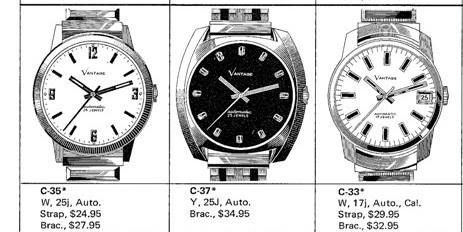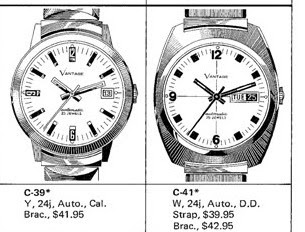by Tom Adelsten
If you get anything at all out of this, remember that Vantage watches are not Hamilton watches.
Hamilton Watch Company bought Vantage to compete with a flood of cheap watches from Switzerland and Japan assembled in the Asia and the Virgin Islands. United States Time Corporation (Timex) developed an inexpensive mechanical movement (the pin pallet discussed below) and garnered a large market share of the watch business. The Swiss and Japanese had to re-engineer their standard movements to compete.
All this occurred less than a decade before quartz LED watches hit the market in 1974 and took off in 1978-82. Think of this as another example of how a digital product pushed an analog product to the side. It all happened in the blink of an eye in corporate time.
HMW created a watch division when it became a holding company. The division included the old Hamilton Watch Company (50% Swiss owned) and Vantage among other brands. Vantage watches are not Hamilton Watches.
If a seller calls them Hamilton-Vantage, then BUYER BEWARE. The seller is uniformed. They should explain that Hamilton’s parent bought Standard Time Corporation to make movements for Vantage. Hamilton would have labeled them like they did with Hamilton-Illinois, but Hamilton Watch Company (HWC) parent brought Vantage into the market to compete with Timex, Bulova’s 7 Jewel Caravelle brand, and Swiss GWC brands. The old Hamilton Watch Company was a division. Vantage also had the distinction of being a division.
Here’s the story:
 |
| Date Date 17 Jewels |
| Electric |
In 1961, Hamilton purchased the Standard Time Corporation of St. Croix, Virgin Islands. The Virgin Islands provided homes for Asian manufacturers to assemble watches for entry into the market dominated by Timex and Bulova’s Caravelle.
To stave off the Swiss monopoly created in the US during WWII, Hamilton diversified its operations and became a conglomerate in 1952. By 1959, Hamilton owned several subsidiaries. Eventually, the company became known as HMW, Incorporated. Management treated Standard Time Corporation as another wholly owned subsidiary. Management had sold 51% of the old Hamilton Watch Company, then a subsidiary, to SSIH of Switzerland.
Standard Time Corporation made some low-quality jeweled pin lever movements and produced movements for Hamilton’s line of Vantage watches, which debuted in 1962. [Note: Hamilton rebranded the failed Ricoh-Hamilton electric watch under Standard Time Corporation and sold it under the Vantage trademark. It was made in Japan not St. Croix.]
 |
| 17 Jewel Stem Wound |
The company made good looking watches, but they did not have Hamilton or Bruen movements in them. Caravels never looked as nice as a Vantage, but Caravels had quasi-Swiss movements. In my opinion, Timex (the other competitor in this part of the market) made lousy looking watches and lousy movements up to and before that point.
 |
| Standard Jeweled Pallet |
I used to collect Vantage watches for a couple of reasons. First, Hamilton’s parent company did own the movement maker and the brand. Hamilton also distributed them in their catalog. Secondly, I liked the style of the watch. Some of the ones that I purchased had pin-pallet escapements, which interests me. Pin pallets work, but not as well and not as long as jeweled escape mechanisms. Timex used pin pallets, but Caravels used jeweled Bulova movements – usually 7 jewels.
Even though Caravels had less jewels than Vantage watches, they work much better than Vantages. Ooops. I let it slip. If you want a vintage watch for everyday wear that tells proper time and works smoothly – don’t buy a Vantage watch . They look great, but they’re clunkers.
If you aren’t familiar with escapements, then you might find the following information important. Every mechanical watch needs power to turn the wheels of the watch. The watch also needs a place for that power to escape or evaporate for the next cycle. Pendulums allow the power of a clock to escape. In a wristwatch, a pallet is the equivalent of a pendulum in a clock with one exception: the pallet is very small.
 |
| Pin Pallet |
A standard pallet accepts the power from the wheels when they turn and pushes a balance wheel. The balance wheel regulates the speed of the movement. If the watch runs fast, then it’s because the balance needs adjusting, so the flow of power equals standard time. The balance doesn’t turn a second hand or anything other than itself. If you see a wheel swinging back and forth in a watch, then that’s the balance. A pin pallet does the same thing as a standard pallet, but instead of jewels that don’t wear out, it uses metal pins (that look like miniature sewing needles) to turn the balance wheel.
By replacing the jewel pallets with vertical metal pins the watch manufacturer has to modify the shape of the escape wheel teeth. The pallets in a traditional lever escapement have two angled faces, the locking face and the impulse face, which engage the escape wheel teeth. If the jewels on the traditional pallets are not adjusted correctly, the watch won’t work. Adjusting the pallet jewels is an important part of the skill set of a watchmaker, but it’s still difficult to master.
It cost less for Hamilton to buy Standard Time Corporation than to tool-up to make the inexpensive watches.
I have run into pin mallet mechanisms in Dollar Watches and the old Timex movements.
Another interesting tidbit, pin pallets have been primarily used in mechanical alarm clocks, kitchen timers and mantel clocks. I consider the technology important to understand, even though it’s inferior and less accurate. Somehow, Hamilton got this to work. The bottom end of the watch market has always held my attention, even though I have sold all but one of my Dollar watches.
Recently, I saw a Vantage watch on eBay offered by a pretty sophisticated seller. He wanted $249 for it in a buy-me-now auction. The seller went on and on about the Vantage watch’s rarity. He wrote about Hamilton this and Hamilton that and so forth. Since I know the Vantage watch story, he surprised me. I can’t imagine putting one’s good reputation on the line like that. Maybe some unsuspecting newbie will buy it and never know the difference. I hope you understand the difference and maybe someday that eBay seller will.
Here’s five models from a 1970 Hamilton Catalog:
And five more:
Copyright 2006-2017 | All Rights Reserved



